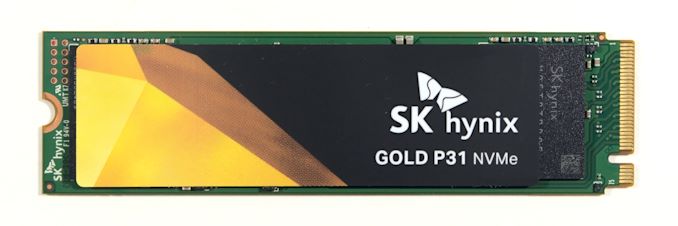The Best NVMe SSD for Laptops and Notebooks: SK hynix Gold P31 1TB SSD Reviewed
by Billy Tallis on August 27, 2020 8:00 AM ESTConclusion
I've rolled my eyes every time SK hynix uses their "4D NAND" moniker to describe their combination of a peripheral under cell layout and charge trap flash. It seemed like a silly exaggeration of a minor advance over other 3D NAND, especially since Intel and Micron have been doing "CMOS under the Array" since their first generation of 3D NAND. But now that I've tested a SSD using this "4D NAND" for the first time, I'll admit it's not purely marketing fluff. This is a genuinely impressive product, and the new 3D NAND seems to be a very important factor. In some very important ways, SK hynix has taken the technological lead, even if this position may not last long.
The SK hynix Gold P31 at first glance seems to be a fairly ordinary high-end NVMe drive, albeit still limited to PCIe 3.0 speeds. It offers well-rounded performance but sets few performance records for this market segment. The write endurance ratings are good and it hit the market with competitive pricing from day one. Taken together with last year's release of the decent Gold S31 SATA SSDs, this is enough to establish SK hynix as an important player in the retail consumer SSD market.
But that's not the whole story when it comes to the Gold P31. The drive's power efficiency is far above the competition; it uses less power than many SATA SSDs while delivering high-end NVMe performance. Thanks to good co-design of their 128L 3D NAND and their in-house NVMe SSD controller, SK hynix has completely redefined our standards for NVMe SSD power efficiency and turned in the most surprising benchmark results in my five years of working for AnandTech.
| High-End NVMe SSD Price Comparison August 26, 2020 |
||||
| 240-280GB | 480-512GB | 960GB-1TB | 2TB | |
| SK hynix Gold P31 | $74.99 (15¢/GB) |
$134.99 (13¢/GB) |
||
| ADATA XPG SX8200 Pro | $44.99 (18¢/GB) |
$69.99 (14¢/GB) |
$134.99 (13¢/GB) |
$249.99 (12¢/GB) |
| Inland Premium | $43.99 (17¢/GB) |
$64.99 (13¢/GB) |
$119.99 (12¢/GB) |
$234.99 (11¢/GB) |
| Team MP34 | $44.99 (18¢/GB) |
$66.99 (13¢/GB) |
$122.99 (12¢/GB) |
|
| Crucial P5 | $54.95 (22¢/GB) |
$79.95 (16¢/GB) |
$149.95 (15¢/GB) |
$339.95 (17¢/GB) |
| WD Black SN750 | $54.99 (22¢/GB) |
$69.99 (14¢/GB) |
$134.99 (13¢/GB) |
$329.99 (16¢/GB) |
| Samsung 970 EVO Plus | $69.99 (28¢/GB) |
$99.99 (20¢/GB) |
$189.99 (19¢/GB) |
$369.99 (18¢/GB) |
| Corsair Force MP600 | $109.99 (22¢/GB) |
$194.99 (19¢/GB) |
$379.99 (19¢/GB) |
|
Surprises like this are why I wish more SSD vendors would sample their OEM drives for review. The P31 is far from SK hynix's first NVMe SSD. It's just the first consumer NVMe SSD they're selling directly as a retail product. They have been manufacturing client NVMe SSDs for years for PC OEMs, but those never find their way onto our SSD testbed.
Some of the first M.2 PCIe SSDs (Samsung XP941 and SM951) were OEM-only products, shipping well before the launch of the retail 950 PRO. We've now seen about six iterations of Samsung's M.2 PCIe SSDs go across our testbeds (in part thanks to help from third-party suppliers who provided some of those OEM-only models for us to review), and because of that we can chart the evolution of their storage technology. But this SK hynix drive comes more or less out of the blue.
Western Digital's first in-house NVMe controllers were announced alongside a pair of OEM drives. The high-end one (SN720) was followed up by a retail counterpart (WD Black gen2) a few months later. I asked Western Digital for a sample of the entry-level OEM SN520 when they introduced that second-generation WD Black, but they couldn't sample it to me. Much later, the retail SN500 arrived and raised the bar for DRAMless SSD performance. More recently, Micron's 2200 series client SSD with their in-house NVMe controller was announced over a year before the Crucial P5 arrived.
Toshiba (now Kioxia) has been the exception; in the past few years they have sampled the XG5, XG6 and BG4 to show off new SSD tech before it makes it into retail drives. OEM SSD products are often managed by separate departments that don't have any PR budget beyond one or two press releases a year. These drives don't need aggressive marketing, but without any review sampling whatsoever we're clearly missing important parts of the picture of the overall SSD market. It's also nice when we can confirm that the drives being used by eg. Dell aren't crap badly in need of an aftermarket replacement.
Even though a close look at recent OEM NVMe SSDs from SK hynix may have tempered the surprise of the Gold P31, it's still an impressive product. It shoots right to the top of my list of recommended SSDs for laptops and finally erases the lingering power efficiency advantage of SATA SSDs, and as a result of that we're giving it one of our coveted Recommended By AnandTech awards.

SK hynix Gold P31: The New Standard for NVMe Laptop SSDs
The SK hynix Gold P31 provides a preview of what how the entry-level NVMe SSD market segment will advance over the next few years, especially as the high-end moves on to PCIe gen4. The Gold P31 still retains plenty of performance for almost all consumer use cases, and will be excellently comfortable sitting in a laptop.











80 Comments
View All Comments
surt - Thursday, August 27, 2020 - link
Am i the odd one out that hasn't needed to use a hard drive tool in years?HardwareDufus - Thursday, August 27, 2020 - link
i don't think so. i've been in the industry for over 30 years. back in those days, some harddrives came with error lists that you had to key into a system bios. then there were all the size limits that require creating multiple partitions... the list goes on...but I think other than running scan disk once a year and my scheduled trims.... I haven't used a harddrive tool on my personal PCs and laptops for over 8 years.
plopke - Thursday, August 27, 2020 - link
For me only once with Samsung it was needed , the other times where it was offered but not needed was crucial /sandisk for slight improved performance or compatibility. I just found it very awkward to not have a website showing specifications or support tools at all.Holliday75 - Thursday, August 27, 2020 - link
Nope. I have no updated the firmware on a SSD in 5+ years. That includes work.MikeMurphy - Friday, August 28, 2020 - link
My practice is to update firmware before I install a fresh copy of Windows. Often I'm greeted with some improved firmware for which I'm grateful. I've been happy with the support on my Crucial, Intel and Samsung drives.TheinsanegamerN - Monday, August 31, 2020 - link
Literally have never updated firmware on any SSD. Also only had issues with 1 SSD where the controller straight up died.Tomatotech - Thursday, August 27, 2020 - link
I've only ever used them as a last resort when trying to rescue a failing SSD (and I've had a couple) - they were useless anyway, might as well not bother. Both times when the drive died the manufacturer happily replaced the drive.With today's cloud tech it's easier than ever to keep a 1TB drive constantly backed up & synced (different things) to several different places. OneDrive offers 1TB, iCloud offers 2TB, etc, and usually anything apart from office docs, project files, and photos doesn't even need to be backed up.
TheinsanegamerN - Monday, August 31, 2020 - link
That only applies to the 1% who can get fiber internet. Ever try to back up 1TB of stuff over a cable connection, usually with a 3-5Mbps upload speed?For most people an external HDD is more usable as a backup method then any cloud storage.
Srikzquest - Thursday, August 27, 2020 - link
Hi Billy, I see that the benchmarks are equally compelling on the performance side as well in addition to power efficiency. Then, why its only the standard for Laptops and not Desktops. Is it due to PCIe gen4 drives on the market?Billy Tallis - Thursday, August 27, 2020 - link
The P31 is definitely a good choice for desktops, but it's not the only reasonable choice—while for laptops, it pretty much is at the moment. Since desktop users have little reason to worry about SSD power efficiency, it can make sense to go with something like a cheaper, somewhat slower Phison E12 drive or even something more low-end, because the real-world performance difference between the P31 and a decent low-end NVMe drive (or even a good SATA drive) is pretty small for most use cases. There's also the 2TB market to consider, since the Platinum P31 isn't available yet.